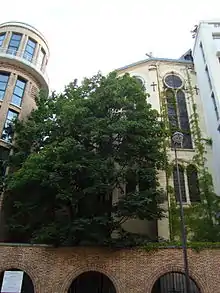Our Lady of Lebanon of Paris Cathedral
Our Lady of Lebanon of Paris Cathedral (Cathédrale Notre-Dame-du-Liban de Paris) is the cathedral and mother church of the Maronite Catholic Eparchy of Our Lady of Lebanon of Paris, part of the Maronite Church, for worship of Eastern Catholic tradition. It is located by the Jesuit Fathers of Sainte-Geneviève school in the 5th arrondissent in Paris, France, constructed 1893–94 by architect Jules-Godefroy Astruc.
| Our Lady of Lebanon of Paris Cathedral | |
|---|---|
| Cathédrale Notre-Dame-du-Liban de Paris | |
 | |

| |
| Location | 15-17 rue d'Ulm 5th arrondissent Paris |
| Country | France |
| Denomination | Maronite Church |
| History | |
| Status | Active |
| Consecrated | 13 May 1894 |
| Architecture | |
| Functional status | Cathedral |
| Architect(s) | Jules-Godefroy Astruc |
| Style | Neo-Gothic |
| Years built | 1893-1894 |
| Administration | |
| Diocese | Maronite Catholic Eparchy of Our Lady of Lebanon of Paris |
| Clergy | |
| Archbishop | Nasser Gemayel |
History
Constructed circa 1893–94 by architect Jules-Godefroy Astruc, it was inaugurated on 13 May 1894, allocated by the Jesuit Fathers of Sainte-Geneviève school in Paris, consecrated to Our Lady of Lebanon, a Marian shrine in Beirut, Lebanon. Following the 1905 French law on the Separation of the Churches and the State, the Jesuits left it. It was then assigned in 1915 to the Maronite worship. In 1937, the Franco-Lebanese home was built around the parish. Renovations of the roof, canopy and rose were made in 1990-1993
Architecture
 Entrance to the church.
Entrance to the church.
The Church of Our Lady of Lebanon also had a cultural role over 30 years, with the classical label Erato who performed most of their recordings in the church. More than 1,200 discs were recorded, including the flautist Jean-Pierre Rampal, trumpeter Maurice André and chamber orchestra Jean-François Paillard.
Interiors
 The interior entrance.
The interior entrance. The nave and chancel.
The nave and chancel.
In 1984, at the suggestion of fr:Robert Calle, director of the Curie Institute, adjoining the place was invested for six months by Spanish artist Miquel Barceló who installed a temporary workshop and painted his series of paintings in the Louvre[1] exposed in the following year in the CAPC musée d'art contemporain de Bordeaux.
References
- [Collective of authors, Miquel Barceló, drawings book - Exhibitions at the National Gallery of the Jeu de Paume and Centre Georges Pompidou, Paris, Jeu de Paume editions and MNAM 1996 (ISBN 2-908901-44-7 ), p. 15-16.]